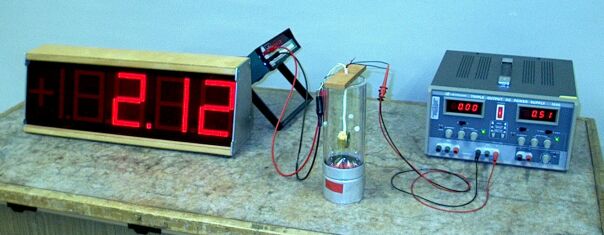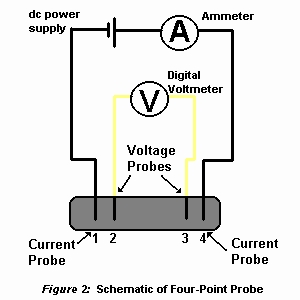
The element encased in the brass nut suspended inside the dewar in the photo above is a Bi2Sr2Ca2Cu3O10 (abbreviated BSCCO) disc with four leads connected as in the schematic below, and two additional leads from a thermocouple attached to the center of the disc. (This figure and the one below it are from a page on the web site of Colorado Superconductor, ©2001 Colorado Superconductor, Inc. Unfortunately, this company no longer exists.) BSCCO is a high-temperature superconductor. That is, it becomes superconductive at or above liquid nitrogen temperature (77 K), as opposed to liquid helium temperature (4 K).

An overhead transparency of this schematic is available for you to display in class, or you may download a .pdf version here to show on the data projector. The figure below shows the physical arrangement of the leads, with their color codes:

A current-limited power supply (B + K Precision, model 1660) takes the place of the DC power supply and ammeter in Figure 2. The current should be limited to not more than 0.5 A. Higher currents than this will damage the superconductive disc. The power supply is connected to the black leads, and the voltmeter goes to the yellow leads. When the power supply is on, a current flows between points 1 and 4 in Figure 2, and, because of the resistance of the disk, a voltage drop develops between points 2 and 3. The voltmeter registers this voltage drop.
When you place the disc in liquid nitrogen, the resistance decreases, and when the temperature of the disc goes below its critical temperature, in this case approximately 108 K, the disc becomes superconductive. When this happens, the resistance of the disc goes to zero, and the voltage measured between points 2 and 3 goes to zero. Because a superconductor has zero resistance, it can sustain large currents without dissipating any power. Also, once a current is started, it can sustain itself without any external input of electromotive force. For techniques that require very large magnetic fields (several Tesla), such as nuclear magnetic resonance (NMR) spectroscopy, or ion cyclotron resonance mass spectrometry (ICR-MS, also known as Fourier-transform mass spectrometry, or FTMS), people use magnets whose coils are made of superconductive wire. The magnet is cooled to below the critical temperature and then “charged” by means of a power supply. When the desired current has been established, the two ends of the magnet are shorted together and the power supply is removed. As long as the magnet is kept below its critical temperature, the current will continue to flow.
You can find an excellent introduction to the theory of superconductivity, with a description of related phenomena, in Chapter 14 of Quantum Physics of Atoms, Molecules, Solids, Nuclei and Particles by Robert Eisberg (A UCSB professor emeritus!) and Robert Resnick (New York: John Wiley and Sons, 1974), on pages 525-533. The phenomenon of superconductivity was discovered in 1911 by Heike Kamerlingh Onnes in the course of his work with liquid helium (Nobel Prize in Physics, 1913). In 1957, John Bardeen, Leon Neil Cooper and J. Robert Schrieffer (another UCSB professor emeritus!) devised a theory, called the BCS theory, which predicts very well the details of superconductivity. When the temperature of a superconducting substance is below the critical temperature, its electrons can interact with the crystal lattice in such a way that they become weakly bound in pairs, called Cooper pairs. These pairs are very large (~10,000 Å), so that the volume occupied by one pair typically contains on the order of 1,000,000 overlapping pairs. It is the correlated behavior of these Cooper pairs (and the ions in the lattice) that is responsible for the phenomenon of superconductivity.
In 1972, Bardeen, Cooper and Schrieffer shared the Nobel Prize in Physics for their development of the BCS theory. You can see the press release that announced this prize, Bardeen’s Cooper’s and Schrieffer’s Nobel lectures and biographies, and other interesting information here.